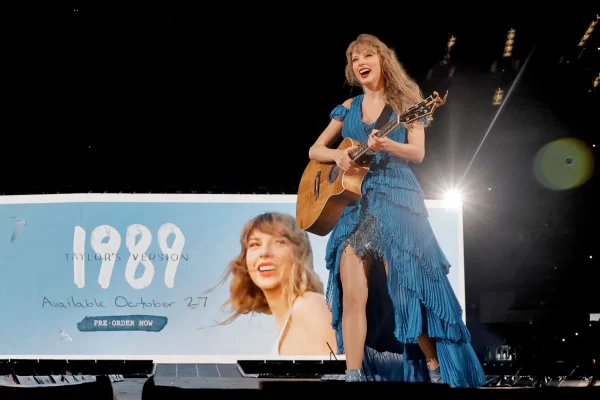Charli XCX Reveals a More Vulnerable Side of Herself on Her Self-Titled Album
The American public conscious mostly remembers Charli XCX, the British pop artist, for her early hits such as “I Love It” with Icona Pop, “Fancy” with Iggy Azalea, and “Boom-Clap” from The Fault in our Stars. In recent years her popularity has decreased and she has slowly faded out of the public eye like many of the pop stars whose careers began and ended in the early 2010s. Despite her low popularity, though by no means is she underground, Charli XCX has remained at the forefront of the developing pop world. After working with the well known Scottish PC music producer SOPHIE on her EP “Vroom Vroom”, Charli XCX has taken her electronic musical influence and run with it. Her most recent hit “Boys” falls into this category and with her critically praised mixtapes from 2017 “Number One Angel” and the more highly praised “Pop 2” she defined herself as a constant force in the modern pop world.
Her newest self-titled album Charli was released on September 13th and was promised to be her most vulnerable work yet. I was very excited about this album mainly due to the quality of the singles released for it. The second single for this album was “Blame it on Your Love” ft Lizzo. This song is a remix of sorts for “Track 10” the last song on Pop 2. This song is really enjoyable mainly due to its upbeat dance-pop production and the charisma powerhouse that is Lizzo and Charli XCX. The song’s lyrics discuss the effect that love has on a person. Their simplicity gets the point across while still keeping the song fun. Despite how much I enjoyed this song, there are problems with it. First off, since this single is based on “Track 10”, it’s hard not to compare the two and it’s hard to deny that the strange Glitch Pop of “Track 10” works far better than the dance-pop of “Blame it on Your Love”. Both of the songs succeed at but I think Track 10 just does it better.
The other problem with this song, which continues to be a problem throughout the album, is the shortness of the quest features on the song. Generally, with any song, short features can be annoying and it can feel like the listener is being cheated out of a better listening experience. This problem is maximized by the fact that Charli XCX works really well with other artists, so many of her songs on this album and others are stylistically changed by the influence of the other artists. Songs like “Gone” with Christine and the Queens and “Cross You Out” with Sky Ferreira are two of the best songs on the album largely due to their features. “Gone” is a dance-pop song where Charli XCX discusses her social anxiety and, “Cross You Out is a synth-pop song clearly inspired by 80s pop ballads about leaving someone toxic behind and finally feeling free according to Charli.
But by limiting an artist’s impact on a song, the song gets hurt. “February 2017” is a little better with its two features, the new indie darling Clairo and electronic music artist Yaeji. Both have notable roles in the song, but while Yaeji gets a nice little section at the end of the song, Clairo seems to have little influence on the song itself. “Blame it on Your Love” and “February 2017” are both still good songs, but I don’t think it’s a coincidence that a lot of the stronger tracks on this album include much longer guest features.
The way that these songs end up coming together on the album creates a personal narrative about Charli and her current emotional journey. The album constantly jumps from fun uptempo dance-pop songs about parties to much moodier and slower songs about anxiety and toxic relationships. This dynamic is shown best in track 7 and 8 on the album. Track 7 is a song called “Thoughts”, a relatively slow song that Charli describes as a “spiral of thoughts” where she thinks about her relationship with her friends and contemplates a lot of her past actions. The most interesting feature of this song is a screeching electronic hum that follows Charli’s voice throughout the song, distorting not only what she says, but every other aspect of the song. This is immediately followed by track 8 the previously mentioned “Blame it on Your Love”. While on paper, this change from depressing slow songs to upbeat dance songs may seem unorganized and ruin the flow of the album, I think it is better to view the album as a stream of consciousness rather than one large story.
This strange dynamic isn’t always constant either. About halfway through the album, there is a stretch of 3 songs, each of which is just Charli without any features, singing about recent struggles she has been going through. These songs are surprisingly lowkey and subtle for an artist who’s in-your-faceness is one of her strongest aspects. These songs hit pretty hard, especially since they seemingly appear out of nowhere in an album that has so far been pretty light-hearted.
Listening to Charli was a musical journey that I thoroughly enjoyed. Charli is by no means is a perfect album and I think at certain points the tracklisting can get a little confusing with its lack of clear cohesion. Still, it shows an interesting glimpse into the world of futuristic pop that Charli XCX seems to predict in her previous works. And while by no means am I a music historian that can guess with confidence the future of any genre, I can say safely that I want what Charli XCX is doing to be the future of pop. Her use of electronics in her music goes beyond the typical use of electronica which tends to involve relatively simple beats that builds up to a drop. While this formula works and isn’t always a recipe for a bad song, it can be boring after a while to hear so many songs with this style, especially if the beats get grating due to their repetitiveness. Charli XCX on the other hand, clearly influenced by her work with SOPHIE and other PC music producers (like AG Cook who produced most of this album), uses electronic methods as a way to make her music more diverse and interesting. From the pop anthem that is “Gone” to the futuristic Glitch Pop of “2099”, the diversity in her music shows how pop doesn’t have to use electronic methods to make repetitive simple beats, but rather as a way to make musically complex songs that are as a plus are fun and catchy.







